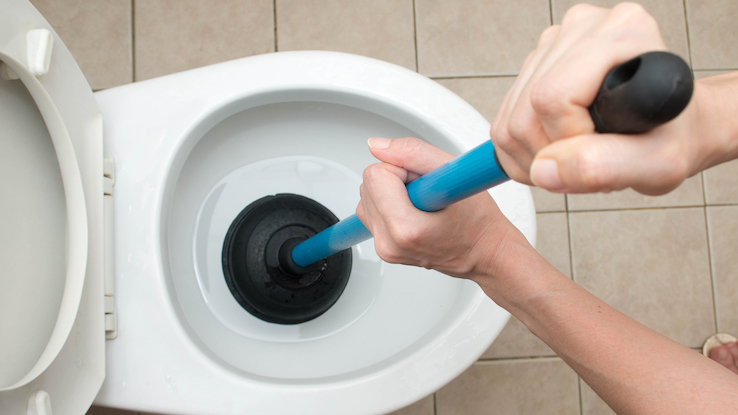Bemis Easy Clean and Change Toilet Seat Problem

Plumbing is a modern marvel of convenience that we often take for granted — until something goes wrong and the smooth functioning of our households comes to a screeching halt. This is especially true when you're dealing with toilet problems, which can certainly feel like issues that you'll want to get resolved as quickly as possible. Fortunately, many common toilet problems are minor issues you can fix yourself without calling in a plumber (and paying emergency fees). If you encounter one of these everyday toilet problems, try the corresponding quick fix to return your bathroom to good working order.
The Ghost Flush
No, the bathroom isn't haunted — but when "ghost flushing" happens, the toilet sounds like it's refilling the same way it does after it's been flushed…without having been flushed. You might hear this refilling sound as often as every few minutes or every few hours throughout the day, and it typically means that water is leaking from the tank into the bowl. This can happen when the flapper — the plug that rests against the bottom of the toilet tank and holds water in the tank until you flush — becomes dirty or damaged.

To determine whether the flapper is leaking, add a few drops of food coloring to the toilet tank and wait half an hour. Check the toilet bowl; if the water in the bowl has the food coloring in it, you have an internal leak. Take a look at the flapper (it resembles a circular disk or a rounded cap with a ball-shaped protrusion on the bottom that sits against a seal on the bottom of the tank) and wipe it off to remove any debris. Clean up any sediment or debris around the flapper, on the seal below it and on the flush valve it's attached to.
If the ghost flushing continues after cleaning, or if the flapper or seal has visible damage like pitting or warping, replace the flapper and seal. If, after replacing the flapper, the toilet is still ghost flushing, you may need to replace the flush valve that the flapper sits on.
This is perhaps the most routine problem you'll encounter with your toilet, and it often happens if someone flushes too much paper. If you flush and notice that the bowl is backing up instead of emptying, a clog is a likely culprit. This type of clogging is especially common on older, low-flow toilets, which you can sometimes flush twice to successfully move the paper through the pipes. If this doesn't work, it's likely that the toilet itself is where the clog lies (and don't keep flushing — you don't want an overflow on your hands).

Your first line of defense? A toilet flange plunger. This is a different type than the old-fashioned cup-style plunger you might be more familiar with. Instead, it has an upper cup with a flared, cylindrical flap extending from the bottom, a design feature that creates a better seal against the hole in your toilet bowl — and therefore more suction to push the clog through. To use this plunger on a clog, tip it slightly in the bowl to let water flow into and fill its chamber; this creates force to push the clog. Keep the plunger handle vertical to prevent the seal from breaking, and plunge in an up-and-down motion quickly. If you find it difficult to plunge, try running the plunger under hot water to soften the rubber.
If the plunger doesn't unclog the toilet, you can use a tool called an auger (or snake) to push the clog through. This is a long, textured cable with a handle that you turn to spin the cable around and down through the toilet's drain pipe. To get to work on the clog, guide the cable down the drain hole in the toilet and start cranking the auger handle. If you feel resistance or the cable stops, you've reached the clog. Keep turning the handle to break up or hook the clog. Pull the auger out — it'll either have broken up the clog or pulled it out, too — and plunge the toilet a few times.
If the plunger and auger don't eliminate the clog, it's time to call in a plumber. The clog may be much farther down the line, and a plumber has heavier-duty equipment to handle the job.
The Stuck or Loose Handle
Your toilet's handle should be a little loose right after you've flushed and the tank is filling back up. But what if it's loose all the time — or doesn't want to budge? There are a few quick fixes to try here.

Start by taking the lid off of the toilet tank. Check out the area where the handle is attached to the tank; on the inside wall of the tank, you'll see a large nut, which holds the handle in place. Using an adjustable wrench, turn the nut to tighten it if the handle is loose, or loosen the nut if the handle is stuck.
If tightening the nut doesn't also tighten up the handle, you may need to adjust the lift chain. This attaches the lift arm — which is on the back of the handle inside the tank — to the flapper and brings the flapper up when you flush the toilet to let water into the bowl. Sometimes this chain can stretch out, making the handle loose because there's not enough tension between the lift arm and the flapper. Unhook the chain from the lift arm and straighten it so there's only about a half-inch of slack remaining. Then, reattach the chain to the lift arm at the new link.
Source: https://www.questionsanswered.net/lifestyle/common-toilet-problems-and-quick-fixes?utm_content=params%3Ao%3D740012%26ad%3DdirN%26qo%3DserpIndex&ueid=24282924-5598-4626-ad35-573f9ec6d106
0 Response to "Bemis Easy Clean and Change Toilet Seat Problem"
Post a Comment